
Hooded Siskin
Encyclopedia
The Hooded Siskin is a small passerine
bird
in the finch family
(Fringillidae), native to South America
. It belongs to the putative clade
of Neotropical siskin
s in the genus
Carduelis
sensu stricto.
There are 11 subspecies
including the Santa Cruz Siskin C. m. santaecrucis of central and eastern Bolivia
. This is sometimes considered to be a separate species
.

The twittering song
may be uttered from a perch or in flight. It is varied and fast and sometimes contains imitations of other birds.
s, scrubland, farmland, parks and gardens. It occurs from sea-level up to 5000 m. In eastern South America it is found from central Argentina
north to central Brazil
. In the Andean
region it occurs from north-west Argentina
and northern Chile
north to central Colombia
. There is an isolated population in south-east Venezuela
, Guyana
and the Brazilian state of Roraima
.
It is commonly found in flocks, feeding in trees or bushes or on the ground. The diet consists mainly of seeds together with buds, leaves and some insects. Geophagy
has been observed in this species.
http://www.springerlink.com/content/r1ukblmke5d3uy1v/fulltext.pdfhttp://www.ardeola.org/files/1260.pdf
Passerine
A passerine is a bird of the order Passeriformes, which includes more than half of all bird species. Sometimes known as perching birds or, less accurately, as songbirds, the passerines form one of the most diverse terrestrial vertebrate orders: with over 5,000 identified species, it has roughly...
bird
Bird
Birds are feathered, winged, bipedal, endothermic , egg-laying, vertebrate animals. Around 10,000 living species and 188 families makes them the most speciose class of tetrapod vertebrates. They inhabit ecosystems across the globe, from the Arctic to the Antarctic. Extant birds range in size from...
in the finch family
Family (biology)
In biological classification, family is* a taxonomic rank. Other well-known ranks are life, domain, kingdom, phylum, class, order, genus, and species, with family fitting between order and genus. As for the other well-known ranks, there is the option of an immediately lower rank, indicated by the...
(Fringillidae), native to South America
South America
South America is a continent situated in the Western Hemisphere, mostly in the Southern Hemisphere, with a relatively small portion in the Northern Hemisphere. The continent is also considered a subcontinent of the Americas. It is bordered on the west by the Pacific Ocean and on the north and east...
. It belongs to the putative clade
Clade
A clade is a group consisting of a species and all its descendants. In the terms of biological systematics, a clade is a single "branch" on the "tree of life". The idea that such a "natural group" of organisms should be grouped together and given a taxonomic name is central to biological...
of Neotropical siskin
Siskin
-Birds:The name siskin when referring to a bird is derived from an adaptation of the German dialect words sisschen, zeischen, which are diminuative forms of Middle High German and Middle Low German words, which are themselves apparently of Slavic origin...
s in the genus
Genus
In biology, a genus is a low-level taxonomic rank used in the biological classification of living and fossil organisms, which is an example of definition by genus and differentia...
Carduelis
Carduelis
The genus Carduelisis a large group of birds in the finch family Fringillidae. It includes the greenfinches, redpolls, goldfinches, linnets, the twite, and the non-African siskins...
sensu stricto.
There are 11 subspecies
Subspecies
Subspecies in biological classification, is either a taxonomic rank subordinate to species, ora taxonomic unit in that rank . A subspecies cannot be recognized in isolation: a species will either be recognized as having no subspecies at all or two or more, never just one...
including the Santa Cruz Siskin C. m. santaecrucis of central and eastern Bolivia
Bolivia
Bolivia officially known as Plurinational State of Bolivia , is a landlocked country in central South America. It is the poorest country in South America...
. This is sometimes considered to be a separate species
Species
In biology, a species is one of the basic units of biological classification and a taxonomic rank. A species is often defined as a group of organisms capable of interbreeding and producing fertile offspring. While in many cases this definition is adequate, more precise or differing measures are...
.

Description
Hooded Siskins are 10 to 14 cm in length. The male is largely green above and yellow below with a black head. It has a narrow yellow collar and a yellow rump. The tail is black with yellow sides to the base and the wings are black with a broad yellow band. Females are duller with a green-brown head, yellow-green breast and sides and a whitish belly.The twittering song
Bird song
Bird vocalization includes both bird calls and bird songs. In non-technical use, bird songs are the bird sounds that are melodious to the human ear. In ornithology and birding, songs are distinguished by function from calls.-Definition:The distinction between songs and calls is based upon...
may be uttered from a perch or in flight. It is varied and fast and sometimes contains imitations of other birds.
Distribution and ecology
It inhabits woodland, savannaSavanna
A savanna, or savannah, is a grassland ecosystem characterized by the trees being sufficiently small or widely spaced so that the canopy does not close. The open canopy allows sufficient light to reach the ground to support an unbroken herbaceous layer consisting primarily of C4 grasses.Some...
s, scrubland, farmland, parks and gardens. It occurs from sea-level up to 5000 m. In eastern South America it is found from central Argentina
Argentina
Argentina , officially the Argentine Republic , is the second largest country in South America by land area, after Brazil. It is constituted as a federation of 23 provinces and an autonomous city, Buenos Aires...
north to central Brazil
Brazil
Brazil , officially the Federative Republic of Brazil , is the largest country in South America. It is the world's fifth largest country, both by geographical area and by population with over 192 million people...
. In the Andean
Andes
The Andes is the world's longest continental mountain range. It is a continual range of highlands along the western coast of South America. This range is about long, about to wide , and of an average height of about .Along its length, the Andes is split into several ranges, which are separated...
region it occurs from north-west Argentina
Argentina
Argentina , officially the Argentine Republic , is the second largest country in South America by land area, after Brazil. It is constituted as a federation of 23 provinces and an autonomous city, Buenos Aires...
and northern Chile
Chile
Chile ,officially the Republic of Chile , is a country in South America occupying a long, narrow coastal strip between the Andes mountains to the east and the Pacific Ocean to the west. It borders Peru to the north, Bolivia to the northeast, Argentina to the east, and the Drake Passage in the far...
north to central Colombia
Colombia
Colombia, officially the Republic of Colombia , is a unitary constitutional republic comprising thirty-two departments. The country is located in northwestern South America, bordered to the east by Venezuela and Brazil; to the south by Ecuador and Peru; to the north by the Caribbean Sea; to the...
. There is an isolated population in south-east Venezuela
Venezuela
Venezuela , officially called the Bolivarian Republic of Venezuela , is a tropical country on the northern coast of South America. It borders Colombia to the west, Guyana to the east, and Brazil to the south...
, Guyana
Guyana
Guyana , officially the Co-operative Republic of Guyana, previously the colony of British Guiana, is a sovereign state on the northern coast of South America that is culturally part of the Anglophone Caribbean. Guyana was a former colony of the Dutch and of the British...
and the Brazilian state of Roraima
Roraima
Roraima is the northernmost and least populated state of Brazil, located in the Amazon region. It borders the states of Amazonas and Pará, as well as the nations of Venezuela and Guyana. The population is 400,000 and the capital is Boa Vista...
.
It is commonly found in flocks, feeding in trees or bushes or on the ground. The diet consists mainly of seeds together with buds, leaves and some insects. Geophagy
Geophagy
Geophagy is the practice of eating earthy or soil-like substances such as clay, and chalk. It exists in animals in the wild and also in humans, most often in rural or preindustrial societies among children and pregnant women...
has been observed in this species.
Phylogeny
It has been obtained by Antonio Arnaiz-Villena et al.http://www.springerlink.com/content/r1ukblmke5d3uy1v/fulltext.pdfhttp://www.ardeola.org/files/1260.pdf

